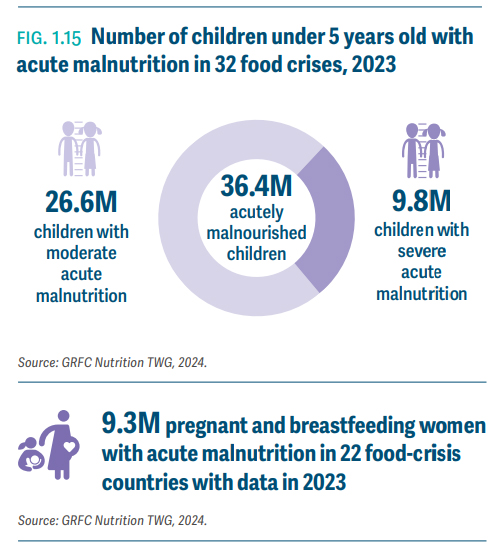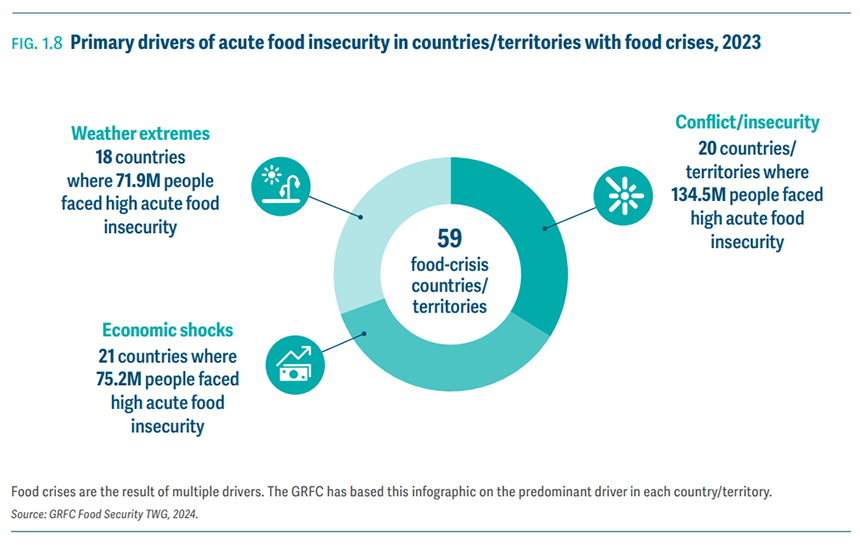Nearly 282 million people in 59 countries and territories experienced high levels of acute hunger in 2023 — 24 million more than the previous year.
Groundxero | April 30, 2024
According to the 2024 Global Report on Food Crises released on April 24, nearly 282 million people or 21.5 percent of the analysed population in 59 countries suffered from acute hunger in 2023, with war-torn Gaza being the territory with the largest number of people facing famine.
The report was produced by the Global Network Against Food Crises, a multi-stakeholder initiative that includes UNICEF and other United Nations organizations, the European Union and the United States Agency for International Development (USAID).
The report analysed a population of 1.3 billion in 2023 in 59 countries. The share of the analysed population facing high levels of acute food insecurity was slightly lower than in 2022. However, the number of people affected has increased by 24 million since 2022, marking the fifth consecutive year of rising numbers.
Children and women have been hit the hardest. There were over 36 million acutely malnourished children under age 5 across 32 countries in 2023, according to the report, with conflict and disaster-related displacement playing a major contributing factor.
António Guterres, Secretary-General of the United Nations, in the foreword of the report noted, “In a world of plenty, children are starving to death. War, climate chaos and a cost-of-living crisis – combined with inadequate action – mean that almost 300 million people faced acute food crisis in 2023. The number of people on the brink of famine rose to over 700 000 – almost double the number of 2022.”
Guterres further added, “The Gaza Strip has the highest number of people facing catastrophic hunger ever recorded by the Global Report on Food Crises, even as blocked aid trucks line up at the border. Conflict in the Sudan has created the world’s largest internal displacement crisis, with atrocious impacts on hunger and nutrition, particularly for women and children.”
According to the 2024 report, there was an increase of 1 million people facing emergency levels of acute food insecurity across 39 countries and territories — with the biggest increase in Sudan — in 2023. And there were over 705,000 people and risk of starvation in 2023 — a fourfold increase since 2016 and the most ever reported.
Key findings of the report:
- In 2023, 281.6 million people or 21.5 percent of the analysed population faced high levels of acute food insecurity in 59 food-crisis countries/territories.
- Nearly 24 million more people faced high levels of acute food insecurity than in 2022; acute food insecurity deteriorated in 12 countries with comparable data between 2022 and 2023.
- Food crises escalated alarmingly in conflict hotspots in 2023 – notably Palestine (Gaza Strip) and the Sudan. The Gaza Strip became the most severe food crisis in IPC and GRFC history.
- The number of forcibly displaced people reached 90M in the 59 countries/ territories – the highest in eight years of GRFC reporting – showing the high correlation between displacement and acute food insecurity. The Sudan became the world’s biggest internal displacement crisis. By the end of 2023, almost 80% of the population of the Gaza Strip was internally displaced.
- Acute malnutrition among children and women continued to deteriorate, especially in conflict-affected areas. In 2023, over 36M children under 5 years old were acutely malnourished in 32 food crisis countries with data, of whom nearly 10M had severe acute malnutrition.
Drivers of acute food insecurity:
According to the report, drivers of acute food insecurity are interlinked and superimposed on structural vulnerabilities that make it more difficult to respond and recover from a shock.
Conflict/insecurity was the primary driver in 20 countries/territories in 2023 with food crises worsening alarmingly in conflict hotspots, particularly Palestine (Gaza Strip) and Sudan, directly affecting 135 million people. It was the main driver in most of the ten largest food crises (by number or share).
Extreme weather was found to be the second most important cause of food crisis. Weather extremes were the main driver for 18 countries with over 72M people facing high levels of acute food insecurity. Many countries were grappling with prolonged recovery from drought or flooding. The El Niño event and climate change-related weather phenomena made 2023 the hottest year on record.
Economic shocks were the main driver in 21 countries with over 75M people facing high levels of acute food insecurity. Decreasing global food prices did not transmit to low-income, import-dependent countries. Continued high public debt limited government options to mitigate the effects of high prices.
Bleak outlook for 2024:
- Conflict/insecurity – especially in Palestine (Gaza Strip), the Sudan and Haiti – will continue to be the main drivers of acute food insecurity throughout 2024.
- While El Niño peaked in early 2024, its full impact on food security – including flooding and poor rains in parts of East Africa, and drought in Southern Africa, especially Malawi, Zambia and Zimbabwe – are likely to manifest throughout the year. Some of the impacts of El Niño may be positive, including better harvests in parts of East Africa and Latin America and the Caribbean.
- Net food-importing, low-income countries, especially those with weakening currencies, are still grappling with high domestic food prices and weak household purchasing power.
- Decreasing humanitarian funding and increasing costs of delivery pose a further threat, already resulting in reduced beneficiary numbers and food assistance rations among many food-insecure populations.
The report projects that another 1.1 million people in Gaza and 79,000 people in South Sudan will be at catastrophe levels by July 2024 for a total of 1.3 million.



